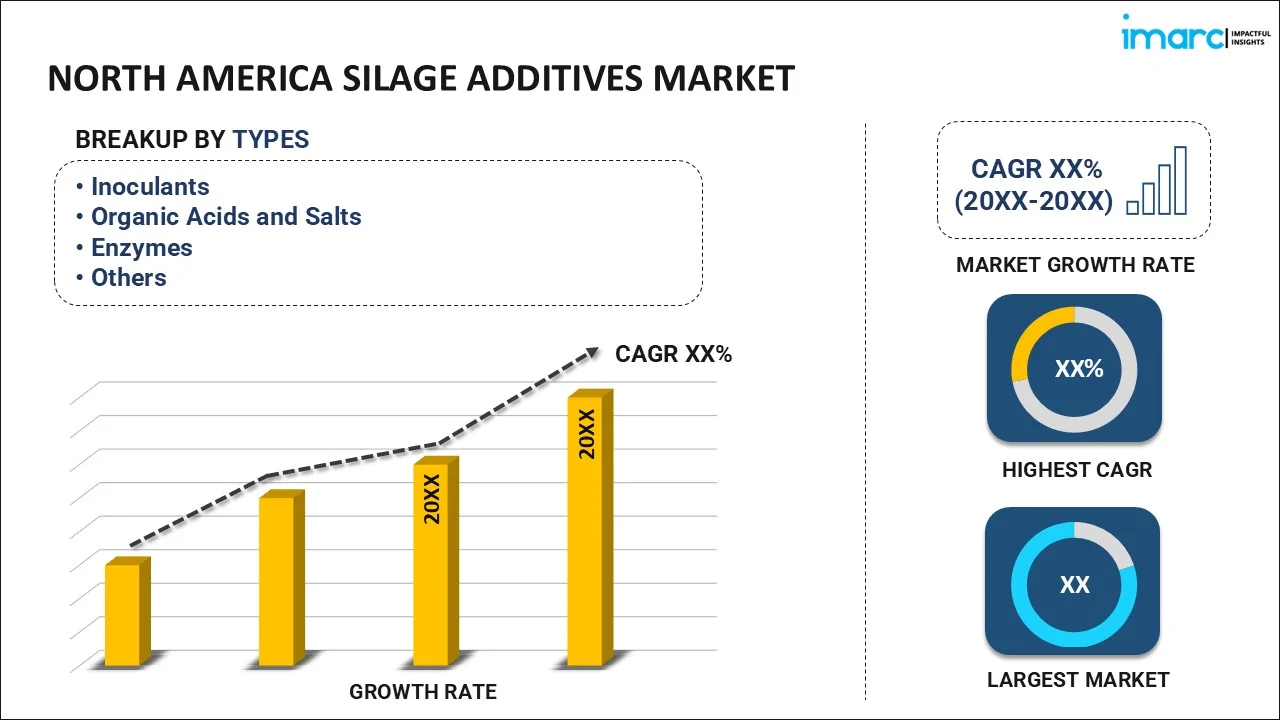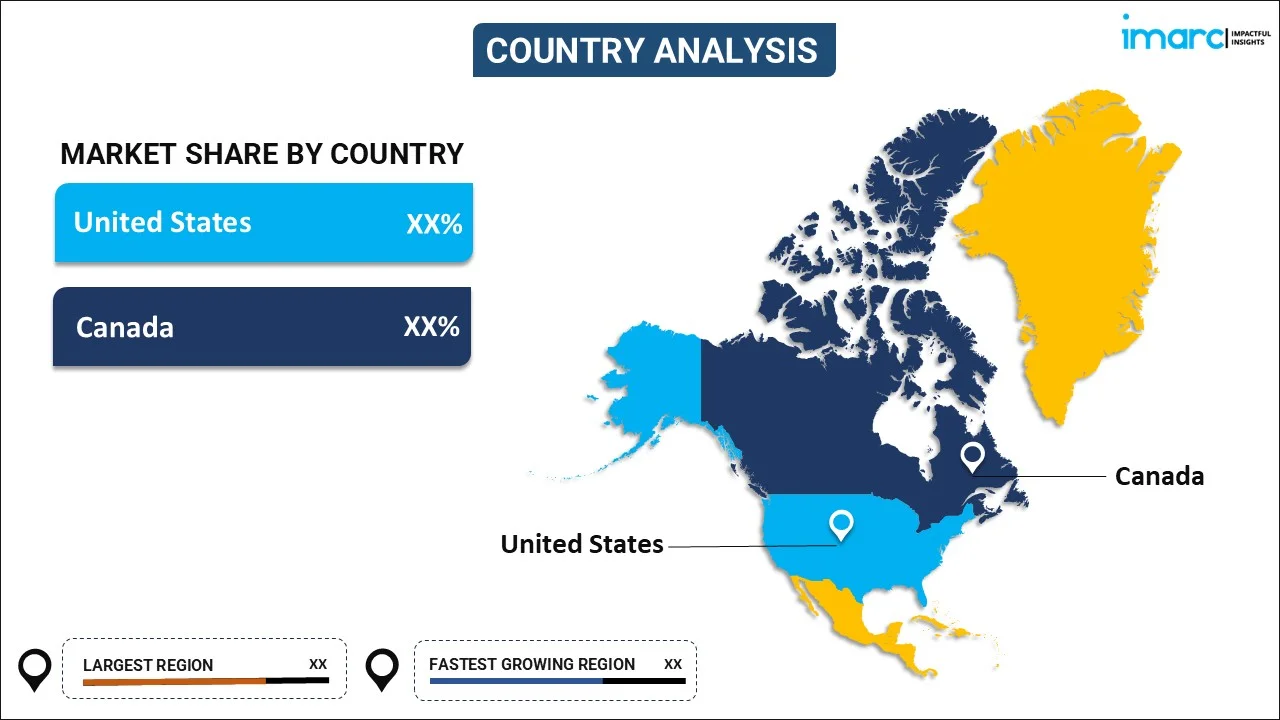
North America Silage Additives Market Size, Share, Trends, and Forecast by Type, Form, Function, Silage Crop and Country, 2025-2033
North America Silage Additives Market Overview:
The North America silage additives market size reached USD 127.68 Billion in 2024. Looking forward, IMARC Group expects the market to reach USD 178.61 Billion by 2033, exhibiting a growth rate (CAGR) of 3.80% during 2025-2033. The market is growing due to increasing demand for high-quality animal feed, improved preservation techniques, and rising livestock production. Additionally, manufacturers focus on advanced formulations, including microbial inoculants and organic acids, to enhance silage stability, nutritional value, and feed efficiency.
|
Report Attribute
|
Key Statistics
|
|---|---|
|
Base Year
|
2024 |
|
Forecast Years
|
2025-2033
|
|
Historical Years
|
2019-2024
|
| Market Size in 2024 | USD 127.68 Billion |
| Market Forecast in 2033 | USD 178.61 Billion |
| Market Growth Rate (2025-2033) | 3.80% |
North America Silage Additives Market Trends:
Rising Demand for High-Quality Forage to Improve Livestock Productivity
The North America silage additives market is expanding due to increasing demand for high-quality forage that enhances livestock health and productivity. Dairy and beef producers are focusing on optimizing feed efficiency, as high-quality silage improves digestion, milk yield, and weight gain. For instance, as per industry reports, in 2023, the United States annual alfalfa dry-hay production was estimated at 49.9 Million tons, representing a 2.2% increase from the previous year. Silage additives, such as bacterial inoculants, enzymes, and organic acids, help preserve nutrients and prevent spoilage, ensuring consistent feed availability. With volatile feed prices, growers look for ways to cut their dependence on off-farm feeds without sacrificing nutrition. The increased focus on managing animal health is also propelling the use of silage preservatives that help reduce mycotoxin contamination and improve aerobic stability. Besides this, big farm livestock operations are investing in newer silage management technologies, such as precision dosing of specific forage-suited additives. Moreover, with increasing demand for high-value meat and milk products, maintenance of optimal quality feed continues to be a high priority, thus keeping silage additives at the forefront of innovative livestock nutrition technologies. This trend is expected to accelerate, supported by technological advancements and increased awareness among livestock producers.
Increasing Adoption of Biological Silage Additives for Sustainability
Sustainability issues and regulatory changes are fueling the growing application of biological silage additives in North America. Farmers are turning away from chemical preservatives to microbial inoculants, which promote fermentation naturally without an excessive demand for synthetic additives. Lactic acid bacteria-inoculants enhance silage stability through favorable fermentation, minimization of dry matter loss, and enhanced palatability. The trend towards biological solutions is also in consonance with the consumer choice for dairy and meat products sourced from sustainable sources, prompting dairy and meat farmers to move towards green feed preservation approaches. Additionally, regulatory agencies are promoting reduced chemical usage in livestock farming, further accelerating the transition to bio-based silage additives. Technological advancements in biotechnology are also broadening the scope of available microbial strains to enable more efficient and targeted fermentation processes. Moreover, as soil and environmental health becomes better understood, feed manufacturers and livestock farmers are placing greater emphasis on sustainable silage solutions that reduce chemical runoff and enhance farm efficiency overall. For instance, in January 2024, Pivot BioA, a U.S. based agriculture company unveiled a study conducted with 30+ dairy producers, that replacing 40 pounds of synthetic nitrogen per acre with Pivot Bio PROVEN® 40 increased silage yield by 4.2% and milk production by 3.4%. This innovation aims to maintain the quality of silage, which in turn boosts farm profits and sustainability. This trend reflects the broader movement toward sustainable agriculture, reinforcing the long-term growth of biological silage additives in the North American market.
North America Silage Additives Market Segmentation:
IMARC Group provides an analysis of the key trends in each segment of the market, along with forecasts at the country level for 2025-2033. Our report has categorized the market based on type, form, function and silage crop.
Type Insights:

- Inoculants
- Organic Acids and Salts
- Enzymes
- Adsorbents
- Preservatives
- Others
The report has provided a detailed breakup and analysis of the market based on the type. This includes inoculants, organic acids and salts, enzymes, adsorbents, preservatives, and others.
Form Insights:
- Dry
- Liquid
A detailed breakup and analysis of the market based on the form have also been provided in the report. This includes dry and liquid.
Function Insights:
- Stimulation
- Inhibition
- Others
The report has provided a detailed breakup and analysis of the market based on the function. This includes stimulation, inhibition, and others.
Silage Crop Insights:
- Corn
- Alfalfa
- Sorghum
- Oats
- Barley
- Rye
- Others
A detailed breakup and analysis of the market based on the silage crop have also been provided in the report. This includes corn, alfalfa, sorghum, oats, barley, rye, and others.
Country Insights:

- United States
- Canada
The report has also provided a comprehensive analysis of all the major regional markets, which include United States and Canada.
Competitive Landscape:
The market research report has also provided a comprehensive analysis of the competitive landscape. Competitive analysis such as market structure, key player positioning, top winning strategies, competitive dashboard, and company evaluation quadrant has been covered in the report. Also, detailed profiles of all major companies have been provided.
North America Silage Additives Market News:
- In November 2023, Case IH, a U.S. based agricultural equipment company, unveiled upgrades for the LB 436 HD large square baler and RB 545 round balers. The advancement aims to enhance durability and efficiency of the equipment which will help in higher silage production.
- In September 2024, Corteva Agriscience, U.S. based company, introduced its Bovalta brown mid-rib (BMR) silage corn hybrids at Canada’s Outdoor Farm Show. The Bovalta improves digestibility and yield, thereby helping farmers increase milk output from silage corn.
North America Silage Additives Market Report Coverage:
| Report Features | Details |
|---|---|
| Base Year of the Analysis | 2024 |
| Historical Period | 2019-2024 |
| Forecast Period | 2025-2033 |
| Units | Billion USD |
| Scope of the Report | Exploration of Historical Trends and Market Outlook, Industry Catalysts and Challenges, Segment-Wise Historical and Future Market Assessment:
|
| Types Covered | Inoculants, Organic Acids and Salts, Enzymes, Adsorbents, Preservatives, Others |
| Forms Covered | Dry, Liquid |
| Functions Covered | Stimulation, Inhibition, Others |
| Silage Crops Covered | Corn, Alfalfa, Sorghum, Oats, Barley, Rye, Others |
| Countries Covered | United States, Canada |
| Customization Scope | 10% Free Customization |
| Post-Sale Analyst Support | 10-12 Weeks |
| Delivery Format | PDF and Excel through Email (We can also provide the editable version of the report in PPT/Word format on special request) |
Key Questions Answered in This Report:
- How has the North America silage additives market performed so far and how will it perform in the coming years?
- What is the breakup of the North America silage additives market on the basis of type?
- What is the breakup of the North America silage additives market on the basis of forms?
- What is the breakup of the North America silage additives market on the basis of function?
- What is the breakup of the North America silage additives market on the basis of silage crop?
- What is the breakup of the North America silage additives market on the basis of country?
- What are the various stages in the value chain of the North America silage additives market?
- What are the key driving factors and challenges in the North America silage additives market?
- What is the structure of the North America silage additives market and who are the key players?
- What is the degree of competition in the North America silage additives market?
Key Benefits for Stakeholders:
- IMARC’s industry report offers a comprehensive quantitative analysis of various market segments, historical and current market trends, market forecasts, and dynamics of the North America silage additives market from 2019-2033.
- The research report provides the latest information on the market drivers, challenges, and opportunities in the North America silage additives market.
- Porter's five forces analysis assist stakeholders in assessing the impact of new entrants, competitive rivalry, supplier power, buyer power, and the threat of substitution. It helps stakeholders to analyze the level of competition within the North America silage additives industry and its attractiveness.
- Competitive landscape allows stakeholders to understand their competitive environment and provides an insight into the current positions of key players in the market.
Need more help?
- Speak to our experienced analysts for insights on the current market scenarios.
- Include additional segments and countries to customize the report as per your requirement.
- Gain an unparalleled competitive advantage in your domain by understanding how to utilize the report and positively impacting your operations and revenue.
- For further assistance, please connect with our analysts.
 Inquire Before Buying
Inquire Before Buying
 Speak to an Analyst
Speak to an Analyst
 Request Brochure
Request Brochure
 Request Customization
Request Customization




.webp)




.webp)












